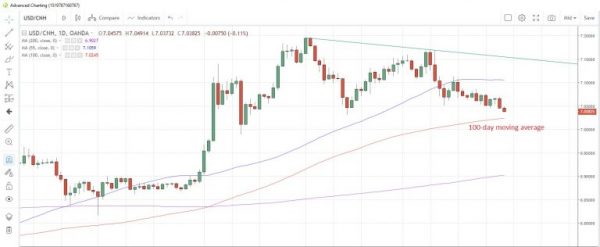Manufacturing PMI at 8-month low
AUD/USD stepped back from four-month highs this morning after China’s official PMI data disappointed. The manufacturing PMI from the National Bureau of Statistics slumped to 49.3, the weakest reading in eight months. Analysts had expected an unchanged reading of 49.8. No doubt the tariff war is still having an impact and it would seem that last month’s uptick was a temporary blip. The non-manufacturing PMI was also below forecast, dipping to 52.8 versus a 53.9 forecast, which was the weakest since March 2016.
AUD/USD was trading at 0.6929, the highest since July 26, before the data and slid back to 0.6917 afterwards. USD/CNH rebounded from near seven-week lows of 7.0370 to 7.0448 but reversed lower to 7.0382 currently. The 100-day moving average is at 7.0245.
USD/CNH Daily Chart
Chile steals Trump’s thunder
The APEC summit that was due to take place in Chile next month has been cancelled by the host nation due to ongoing social unrest and protest in the country. Trump was going to use the event for a ceremonial signing of the Phase One trade agreement with China’s President Xi. Whether a new venue can be arranged at such short notice remains to be seen. I’m sure Trump will want the headline-grabbing deal to be signed off anyway. Indices took a mild dip on the news but soon recovered losses.
While on the trade negotiations, US Treasury Secretary Mnuchin said that no trips to Beijing are planned for face-to-face meetings, but noted that phone conversations have been productive. He later told the New York Times that the deal will likely be signed in November.
Bank of Japan cuts growth, inflation forecasts
The Bank of Japan kept both benchmark interest rate and asset purchase programme unchanged at today’s policy meeting, as expected. In the accompanying statement, the reference to keeping rates low or lower saw the calendar-based timeframe removed, implying an open-ended policy. Previously the guidance stated “at least through Spring 2020″. Basically, Japan rates are not going higher. It saw Japan GDP growth likely below potential temporarily, partly due to overseas risks.
In its quarterly outlook, 2019/20 GDP growth was cut to 0.6% from 0.7% while 2020/21 growth was trimmed a larger 0.2% to 0.7%. All measures of inflation through to the 2021/22 financial year were trimmed between 0.1% and 0.3%.
USD/JPY spiked 10 points higher to 108.75 after the announcement but that proved to be a temporary blip and it’s now back at 108.64.
Euro-zone growth seen slowing
Like the US, third quarter growth in the Euro-zone is expected to slow from the previous quarter. Estimates suggest the economy expanded at a slower 1.1% pace from 1.2% in Q2, while on a quarter-on-quarter basis growth is expected to be a lower +0.1%. German retail sales for September and Euro-zone consumer prices for October complete the European calendar.
The US session features personal income and spending for September (both increasing at a slower pace from August) along with the Chicago PMI reading for October. That’s expected to improve to 48.0 from 47.1, the latest survey shows.
